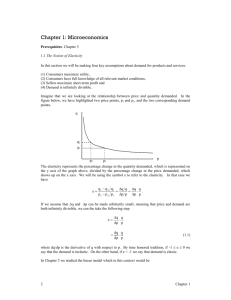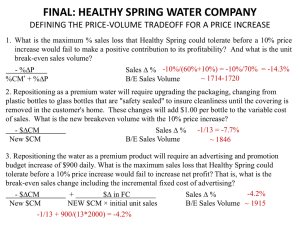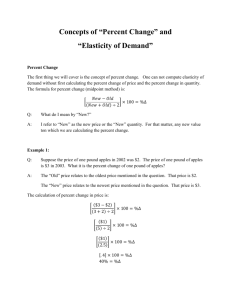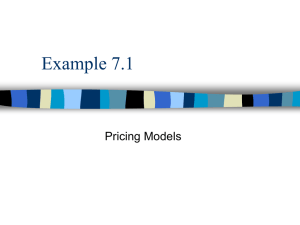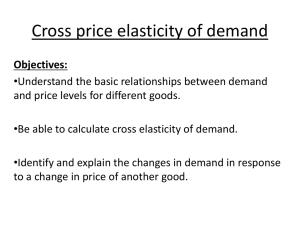Bhuyan Slides
advertisement
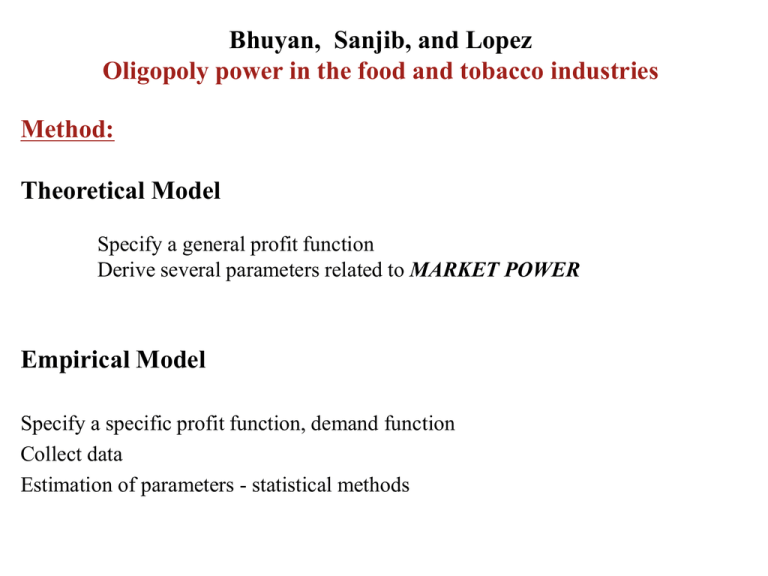
Bhuyan, Sanjib, and Lopez Oligopoly power in the food and tobacco industries Method: Theoretical Model Specify a general profit function Derive several parameters related to MARKET POWER Empirical Model Specify a specific profit function, demand function Collect data Estimation of parameters - statistical methods Method: Theoretical Model -Profit function j (P(Y ) Y j C j (W ,Y j ) P(Y ) price (output dem and function) W vector of input prices Y j firm j's output C j cost of producing Y j at prices W Differentiate profit with respect to output j j PY sYj Revenue to cost ratio j Y Cj j Y s j lnC j 1 j lnY Method: Theoretical Model: Parameters ln C j outputelasticity of cost (linked to MC) 1 / j j ln Y Output elasticity of cost - reciprocal of “economies of size” eg. for a 1% increase in output, is there more or less percent change in cost? j ln Y = conjectural elasticity j ln Y (changein industry outputY in responseto a changein the outputof firm j ) ln P(Y ) elasticity of outputdem and for the industry ln P How doesindustry outputreact to a changein the price level? Method: Theoretical Model: Lerner Index (L) Measures degree of the exercise of oligopoly power L P MC P MC MC for the industry industry level conjectural variations elasticity elasticity of output dem and Method: Empirical Model Specify a Translog Cost function (Transcendental-logarithmic) Ln(C) = f(W,Y,T) C = industry total cost Y = industry output T = time trend W = vector of input prices (wi) Logarithmic differentiation (Shephard’s Lemma) factor (input) share equations lnC wi x i Si ln w i C (input share equations ) = f (w i ,Y,T) Method: Empirical Model Specify a Cobb-Douglas output demand function (derived demand facing industry) lnY D(lnP, lnq, ln Z, lnT) P price of output Z substitute price q incom e T tim e trend Method: Estimation Statistical methods - estimate the parameters of a system of equations 4 input share equations (KLEM) (derived from C=C (W,Y,T) 1 demand function (Cobb-Douglas) 1 equation representing profit max criterion Annual data 1972 – 1987 40 food and tobacco processing industries: SIC 4 digit level L - Lerner index - elasticity of returns to scale - conjectural variation elasticity for the industry ( = 0 => no strategic activity e.g. price taking) - output demand elasticity Results: 1) Testing the Lerner index H0: L = 0 Reject => evidence of oligopoly power (price distortion) Rejected - 37 of 40 industries (average L = 0.33) "degree of oligopoly power is significant" Results: 2) Other Parameters - conjectural variation elasticity - mostly greater than zero and significant - evidence of strategic behaviour - output demand elasticity – inelastic in all cases - elasticity of scale ..... mostly increasing returns e.g. > 1 Constant returns to scale - CRS rejected for 33 industries Ho: = 0 20 industries – increasing returns 13 industries – decreasing returns >1 >1 Statistical Significance – high in most cases Aggregate Industries SIC 2: - Food Industries - Tobacco Industries - Food & Tobacco Comparisons with Previous Research
